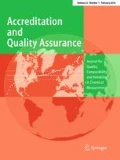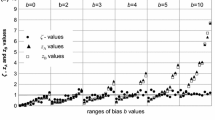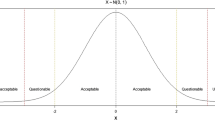Abstract
Methods of utilizing the Youden plot obtained from interlaboratory comparison tests are proposed. The Youden plot is a powerful tool for visually evaluating between- or within-laboratory errors. However, there are no generally applicable methods to indicate the anomalies in the between- and the within-laboratory errors in qualitative terms. An evaluation frame was therefore developed in this study as an indication method. Moreover, the Youden plot is considered to be useful for visually assessing the comprehensive performance of laboratories using two types of results. Although the confidence ellipse has been proposed in ISO 13528:2005 for this purpose, robust determination of the parameters has not yet been implemented. In the present study, robust determination of one of the parameters, the correlation coefficient, was developed. Our proposals were analytically validated using two types of statistical models. In addition, the properties were evaluated through computational simulations. From the results obtained, it can be concluded that our proposals are practically applicable to actual interlaboratory comparison tests.






Similar content being viewed by others
References
ISO/IEC 17025 (2005) General requirements for the competence of testing and calibration laboratories. ISO, Geneva
ISO/IEC 17043 (2010) Conformity assessment—general requirements for proficiency testing. ISO, Geneva
ISO 13528 (2005) Statistical methods for use in proficiency testing by interlaboratory comparisons. ISO, Geneva
Youden WJ (1959) Graphical diagnosis of interlaboratory test results. Ind Qual Control 15(11):133–137
Horwitz W (1995) Protocol for the design, conduct and interpretation of method performance studies. Pure Appl Chem 67(2):331–343
Mollin DL, Hoffbrand AV, Ward PG, Lewis SM (1980) Interlaboratory comparison of serum vitamin B12. J Clin Pathol 33:243–248
Marchetto A, Mosello R, Bianchi M, Geiss H, Giorgio S, Lanza GS, Tartari GA, Muntau H (1996) Interlaboratory exercises to compare analytical method performances. Microchim Acta 123:95–102
Loring DH, Rantala RTT (1988) An intercalibration exercise for trace metals in marine sediments. Marine Chem 24:13–28
International Union of Independent Laboratories (UILI) (2008) Inter laboratory practice report 2008. UILI, Washington
Japan Environmental Measurement and Chemical Analysis Association (JEMCA) (2006) Report on proficiency test based on ISO/IEC Guide 43-1—Nikkan 40-07WM (Nikkan-40). JEMCA, Tokyo, Japan (in Japanese)
JEMCA (2006) Report on proficiency test based on ISO/IEC Guide 43-1—P-EWV-2005 (Nikkan-31). JEMCA, Tokyo, Japan (in Japanese)
JEMCA (2006) Report on proficiency test based on ISO/IEC Guide 43-1—Nikkan 39-07WL (Nikkan-39). JEMCA, Tokyo, Japan (in Japanese)
JEMCA (2006) Report on proficiency test based on ISO/IEC Guide 43-1—Nikkan 42-08WM (Nikkan-42). JEMCA, Tokyo, Japan (in Japanese)
JEMCA (2006) Report on proficiency test based on ISO/IEC Guide 43-1—Nikkan 44-08WP (Nikkan-44). JEMCA, Tokyo, Japan (in Japanese)
Bremser W, Lücke F-K, Urmetzer C, Fuchs E, Leist U (2010) An approach to integrated data assessment in a proficiency test on the enumeration of Escherichia coli. J Appl Microbiol 110:128–138
Heath E, Kosjek T, Farre M, Quintanac JB, de Alencastroe LF, Castiglioni S, Gans O, Langford K, Loos R, Radjenović J, Rocca LM, Budzinski H, Tsipi D, Petrovic M, Barcelo D (2010) Second interlaboratory exercise on non-steroidal anti-inflammatory drug analysis in environmental aqueous samples. Talanta 81:1189–1196
Heyden UV, Smeyers-Verbeke J (2007) Set-up and evaluation of interlaboratory studies. J Chromatogr A 1158:158–167
Jackson JE (1956) Quality control methods for two related variables. Ind Qual Control 12(7):4–8
Boley NP, De Bièvre P, Taylor PDP, Uldall A (2001) Requirements vs acceptability in proficiency testing schemes and other interlaboratory comparisons. Accred Qual Assur 6:244–251
Rebeski DE, Winger EM, Ouma JO, Pages SK, Büscher P, Sanogo Y, Dwinger RH, Crowther JR (2001) Charting methods to monitor the operational performance of ELISA method for the detection of antibodies against trypanosomes. Vet Parasitol 96:11–50
Yamauchi J (ed) (1986) Statistical tables and formulas with computer applications. Japanese Standards Association, Tokyo Japan (in Japanese)
ISO/IEC Guide 43:1997 (1997) Proficiency testing by interlaboratory comparisons. ISO, Geneva
Heydorn K (2008) Proficiency testing in the light of a new rationale in metrology. Accred Qual Assur 13:217–222
Acknowledgments
This study was conducted as a part of the activities of the Technical Advisory Committee for Proficiency Testing of the Japan Environmental Measurement and Chemical Analysis Association (JEMCA). The authors acknowledge JEMCA’s support of this study through the supplementation of the proficiency test data. The provided data were handled in accordance with the security protection policy of JEMCA. In particular, the authors would like to express their sincere gratitude to Mr. Shun-ichi Fukuda and Ms. Satoko Umino of JEMCA. The authors also express their deep gratitude to Dr. Hideyuki Tanaka, Dr. Kensei Ehara, and Dr. Akira Miyazaki of the National Institute of Advanced Industrial Science and Technology (AIST) for providing valuable comments during the course of this study. The authors would like to thank the anonymous reviewers as well, for their valuable comments and suggestions to improve the quality of the paper.
Author information
Authors and Affiliations
Corresponding author
Appendices
Appendix 1: Application of the proposed methods to actual comparison data
The evaluation frame and confidence ellipse proposed in this study were applied to actual comparison test data of analyses of trichloroethylene [11], COD-Mn [12], total chromium [13], and isoxathion [14] in liquid water, hosted by JEMCA. Figure 7 shows the results. The straight lines show the evaluation frames of |z ui | = 3 and |z vi | = 3, and the ellipses are the confidence ellipse with χ 2(1−p) (2) = 12 in Eq. (17) (the significance level is 0.25 %).
Appendix 2: Derivation of Eq. (21)
This appendix provides a theoretical explanation of the derivation of Eq. (21) in the main paper. The equation can be derived from the theorem below:
Theorem
For x and y derived from the bivariate normal distribution with the population mean (μ x , μ y ) and the population correlation coefficient ρ, the following are true:
-
(i)
The probability that \( \left( {x-\mu_{x} ,y-\mu_{y} } \right) \) is positioned in both the first and third quadrant is given as \( 1/ 4 + 1/ 2\pi \cdot { \arcsin }\left( \rho \right) \) , where \( -\pi / 2 \le { \arcsin }\left( \rho \right) \le \pi / 2 \).
-
(ii)
The probability that \( \left( {x-\mu_{x} ,y-\mu_{y} } \right) \) is positioned in both the second and fourth quadrant is given as \( 1/ 4 { }-{ 1}/ 2\pi \cdot { \arcsin }\left( \rho \right) \), where \( -\pi / 2 \le { \arcsin }\left( \rho \right) \le \pi / 2 \).
Based on the above theorem,
is true, where sgn(.) is the signature function that gives sgn(z) = 1, 0, or −1 when z > 0, z = 0, or z < 0, respectively. Thus, when (x i , y i ) is a pair derived from the bivariate normal distribution and their population means are estimated as (\( \hat{\mu }_{x} \), \( \hat{\mu }_{y} \)), the following equation can be employed to estimate ρ:
However, since it is possible that \( x_{i} -\hat{\mu }_{x} = 0 \) or \( y_{i} -\hat{\mu }_{y} = 0 \), Eq. (23) may cause confusion. Practically, setting n + as the number of the pair of \( \left( {x-\hat{\mu }_{x} ,y-\hat{\mu }_{y} } \right) \) coordinated in the first or third quadrants and n − as the corresponding number coordinated in the second or fourth quadrants, the estimation of ρ can be given as follows:
This is Eq. (21).
Rights and permissions
About this article
Cite this article
Shirono, K., Iwase, K., Okazaki, H. et al. A study on the utilization of the Youden plot to evaluate proficiency test results. Accred Qual Assur 18, 161–174 (2013). https://doi.org/10.1007/s00769-013-0978-7
Received:
Accepted:
Published:
Issue Date:
DOI: https://doi.org/10.1007/s00769-013-0978-7





